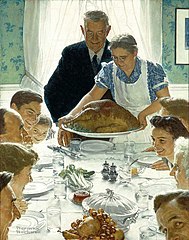
Do you recognize this iconic Norman Rockwell picture? The artist created it in 1943 with the title Freedom from Want to illustrate one of Roosevelt’s Four Freedoms justifying American participation World War II. The illustration went on to represent the perfect American Thanksgiving Celebration. Three generations gather around the dinner table to enjoy a truly enormous turkey, and side dishes of celery, jellied cranberry sauce, and something in the covered dish.
Today’s story is not about turkeys or families. It’s about the dish of jellied cranberry sauce located next to the celery at the center of the table.
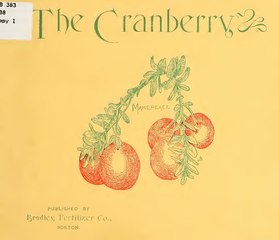
Cranberries are one of three American fruits grown commercially. [The other two are blueberries and Concord grapes.] When the Pilgrims arrived in America in 1620, the Wampanoag people had been harvesting what they called sasumuneash for hundreds of years. The fruit was eaten fresh, or dried to become nasampe, or mixed with dried meat and animal fat to produce pemican.
The Europeans were familiar with a similar plant they called craneberry, because it’s flower resembled the head of a Sandhill crane. I don’t see the resemblance, but see what you think.

Sandhill Cranes 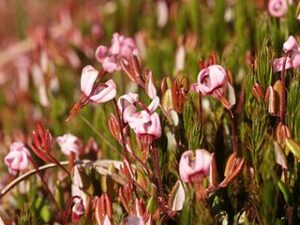
Cranberry Blossoms
The English plant grew in boggy areas of southern England; the American variety in bogs created when glaciers receded after the Ice Age.
Henry Hall, a veteran of the Revolutionary War, started the first commercial cranberry cultivation in Dennis, Massachusetts. Other families followed his example, and developed a business model. They either cultivated cranberries or harvested them, and then sold the berries to a middle man who sold them in urban areas like Boston or New York
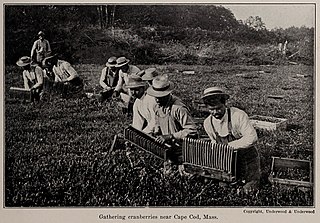
Dry harvesting cranberries off the vine by hand is backbreaking work still in use for harvesting the whole berries sold in grocery stores. Only about 5 percent of the cranberry harvest is sold as fresh fruit, because cranberry season only runs from mid-September until mid-November, after which the vines are dormant until spring.
In 1910, Marcus L. Urann of Hanson, Massachusetts purchased a cranberry bog and realized he could use the new commercial canning industry to extend and expand cranberry sales. However, dry harvesting was too slow for his expansion plans.
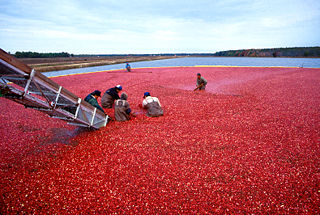
The innovation of wet harvesting changed the business model. When cranberry bogs flood, the water loosens the berries from the vine. The fruit has four buoyant chambers allowing the fruit to float on the surface where it can easily be harvested.
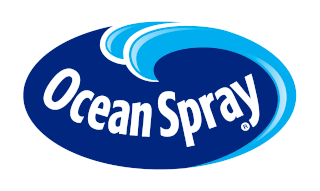
In the 1930s, Urann persuaded his two major competitors, John C Makepeace of AD Makepeace Company and Elizabeth F. Lee of Cranberry Products Company to join with him in a cooperative to minimize price and volume instabilities. The cooperative, first known as Cranberry Canners, is the core of Ocean Spray which has now expanded to 700 families of cranberry growers in the United States, Canada, and Chile.
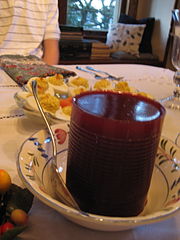
Alas, not every cranberry is perfect in shape. Enter the jellied cranberry log, introduced in 1912 and available nation wide in 1941. A convenient attribute of cranberry jelly is that the cranberry’s naturally occurring pectin allows the jelly to thicken and set in the can.
Ocean Spray sells 80 percent of its canned jellied cranberry sauce in Thanksgiving week. The company produces 70 million cans annually, each can containing 220 cranberries.
Today, Ocean Spray’s product line includes a variety of cranberry juices and craisen snacks as well as fresh and canned cranberry products. In the week leading up to Thanksgiving, Americans consume 20 percent of the fresh cranberry crop – 80 million pounds.
Cranberries, the small red fruits that grow in a bog, are an American staple either as a sauce at Thanksgiving or as a healthful juice.
If you want to virtually observe how cranberries move from the bog to the can, check out this 3-minute video from Ocean Spray.
🍒🍒🍒
Illustrations
Freedom From Want [The Thanksgiving Picture] 1943 by Norman Rockwell.
The Cranberry. Bradley Fertilizer Co.
Sandhill Crane in New Mexico by Cclehnen.
Cranberry Flower by Bernd Hayhold.
Gathering Cranberries Near Cape Cod, MA.
Wet Harvest at a NJ Cranberry Bog.
Ocean Spray Logo. Ocean Spray Cranberries, Inc.
Cranberry Sauce From a Can by Daniel Morrison.
Hil Bey Ramdene. “How Canned Cranberry Jelly Became a Thanksgiving Icon.” Kitchn. Nov 21, 2014.
K. Annabelle Smith. “This Man Made the First Canned Cranberry Sauce.” Smithsonian Magazine. Nov 27, 2013.

Sandra Wagner-Wright holds the doctoral degree in history and taught women’s and global history at the University of Hawai`i. Sandra travels for her research, most recently to Salem, Massachusetts, the setting of her new Salem Stories series. She also enjoys traveling for new experiences. Recent trips include Antarctica and a river cruise on the Rhine from Amsterdam to Basel.
Sandra particularly likes writing about strong women who make a difference. She lives in Hilo, Hawai`i with her family and writes a blog relating to history, travel, and the idiosyncrasies of life.

